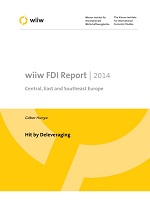Hit by Deleveraging
Gabor Hunya and Monika Schwarzhappel
wiiw FDI Report No. 2014-06, June 2014
125 pages including 94 Tables and 8 Figures
Content
- The first part of the publication contains an analysis of the latest FDI trends.
The analysis highlights the modest recovery of FDI in 2013. - The second part of the publication contains two sets of tables:
- Tables I: total flow and stock data, FDI flow by components and FDI income, FDI per capita and other FDI reference parameter (2005-2013)
- Tables II: detailed FDI data by economic activity and by country (last four years)
The main sources of data are the central banks of the individual Central, East and Southeast European countries.
General Description (PDF) | Table of contents (PDF)
Abstract
The first part of this report provides an analysis of the 2013 FDI trends in 23 CESEE countries, pointing to uneven developments. Inflows were decimated in the NMS first of all in Poland, they stagnated in the SEE countries and boomed in Russia. Declines were partly of a statistical nature, partly the result of the withdrawal of investment reserves. The high inflows to Russia were over-compensated by even higher outflows to other countries. There has been no correlation between economic growth and FDI inflow in the CESEE region over several years. But the diminishing amount of FDI in relation to GDP and gross fixed capital formation suggests that it is not FDI that drives economic growth. A diminishing number of greenfield investment projects underpins this conclusion for 2013.
Forecasts for economic growth in 2014 and first-quarter trends in FDI flows and greenfield projects suggest a recovery in the CESEE countries which are not directly affected by Ukraine crisis. There are signs of a return of manufacturing FDI to the NMS while inflows to Russia are plummeting.
The second part of this report contains two sets of tables: Tables I cover FDI flow and stock data, FDI flows by components and related income; Tables II provide detailed FDI data by economic activity and by country. The main sources of data are the central banks of the individual Central, East and Southeast European countries.
The wiiw FDI Database is available online:
This online access with a modern query tool supports easy search and download of data.
The wiiw FDI Database contains the full set of FDI data with time series starting form 1990 as far as available.
Access to wiiw FDI Database
Reference to wiiw databases: wiiw FDI Database
Keywords: foreign direct investment, balance of payments, income repatriation, statistics, new EU Member States, Southeast Europe, CIS
JEL classification: C82, F21, O57, P23
Countries covered: Albania, Belarus, Bosnia and Herzegovina, Bulgaria, CIS, Croatia, Czechia, Estonia, Hungary, Kazakhstan, Latvia, Lithuania, North Macedonia, Moldova, Montenegro, New EU Member States, Poland, Romania, Russia, SEE, Serbia, Slovakia, Slovenia, Turkey, Ukraine, Kosovo
Research Areas: International Trade, Competitiveness and FDI
ISBN-13: 978-3-85209-038-2
